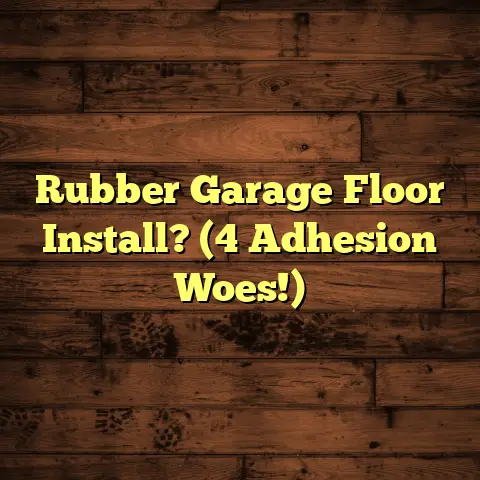Fixing Plywood To Concrete (4 Steps to Success!)
Ever tried a DIY project that turned into a full-blown comedy show?
I remember this one time, my buddy Dave decided to install new flooring himself.
He envisioned a smooth, beautiful finish.
Instead, he ended up with mismatched tiles, a crooked subfloor, and his overenthusiastic golden retriever, Sparky, running around with a roll of adhesive stuck to his fur.
The whole thing was a hilarious mess!
But hey, at least it made for a great story.
Let’s dive into the world of fixing plywood to concrete.
It might sound intimidating, but with the right approach, you can avoid a Sparky- adhesive situation of your own.
Section 1: Understanding the Challenge
Why would you even want to fix plywood to concrete?
Well, there are a few common scenarios that might lead you down this path.
Maybe you’re dealing with drafty floors that feel like they’re whispering winter secrets into your home.
Or perhaps you’re battling the dreaded squeaky boards, those telltale signs of a floor that’s seen better days.
And then there’s the “surprise” concrete slab – the one that seems to have its own agenda, uneven and unpredictable.
I’ve seen it all, folks.
The truth is, concrete and plywood aren’t exactly best buddies.
Concrete is a strong, dense material, perfect for providing a solid foundation.
Plywood, on the other hand, is a wood product, offering flexibility and a surface ideal for many types of flooring.
The challenge arises because concrete is porous and can wick moisture, while plywood is susceptible to warping and rot when exposed to moisture.
This difference can create problems if they’re not properly joined.
Think of it like trying to mix oil and water – it can be done, but it requires some finesse and the right ingredients.
Section 2: The Essential Tools and Materials
Okay, before we get our hands dirty, let’s talk tools.
Having the right equipment is like preparing for a first date: a little awkward if you don’t know what you’re doing, but absolutely essential for success.
Here’s what you’ll need:
- Measuring Tape: (This one always seems to disappear right when you need it, doesn’t it?)
- Circular Saw or Table Saw: For cutting the plywood to size.
- Drill with Concrete Bits: We’re going to be tackling some tough stuff.
- Hammer Drill (Optional but Recommended): Makes drilling into concrete much easier.
- Construction Adhesive: The type specifically designed for bonding wood to concrete.
- Concrete Screws or Fasteners: For a secure hold.
- Level: To make sure everything is nice and even.
- Safety Glasses: Protect those peepers!
- Dust Mask: Concrete dust is no joke.
- Gloves: Keep your hands clean and protected.
- Shop Vacuum: For cleaning up the concrete surface.
- Straight Edge: For marking straight lines on the plywood.
- Pencil or Marker: For marking cuts and measurements.
- Moisture Meter (Optional): To check the moisture levels in the concrete.
Materials List:
- Plywood: Choose the appropriate thickness and grade for your flooring needs. I usually recommend at least ¾ inch for most applications.
- Construction Adhesive: Like I said before, make sure it’s specifically designed for wood-to-concrete bonding. I often use brands like Loctite PL Premium or Liquid Nails Heavy Duty.
- Concrete Screws or Fasteners: These need to be long enough to penetrate the concrete and securely hold the plywood. Brands like Tapcon are reliable.
- Self-Leveling Compound (Optional): If your concrete is uneven, this will help create a level surface.
- Moisture Barrier (Optional): If moisture is a concern, a vapor barrier can help protect the plywood.
Now, let’s talk about these materials a little more.
Choosing the right construction adhesive is like picking a partner: you want something strong, reliable, but not too clingy (you might need to make adjustments later!).
I’ve found that polyurethane-based adhesives work particularly well because they create a strong, waterproof bond.
Concrete screws or fasteners are your security guards.
They’re there to make sure that plywood stays put, even when things get tough.
Tapcon screws are a popular choice because they’re easy to install and provide excellent holding power.
And don’t forget about safety gear!
Safety glasses and a dust mask are non- negotiable.
Trust me, concrete dust is not something you want to mess with.
It can irritate your eyes and lungs, and nobody wants that.
Section 3: Step-by-Step Guide to Fixing Plywood to Concrete
Alright, with our tools and materials ready, let’s get down to business.
Here’s a step-by-step guide to fixing plywood to concrete:
1. Preparation is Key
Before you even think about laying down that plywood, you need to prep the concrete surface.
Think of it as a spa day for your floor.
First, give the concrete a thorough cleaning.
Use a shop vacuum to remove any dirt, dust, and debris.
You want a clean surface for the adhesive to bond to.
Next, inspect the concrete for any cracks or unevenness.
If you find any significant cracks, fill them with a concrete patching compound.
For uneven surfaces, consider using a self-leveling compound.
This will create a smooth, level surface for the plywood.
And while you’re at it, check the moisture level of the concrete.
Excessive moisture can cause the plywood to warp and rot, so it’s essential to address any moisture issues before you start.
You can use a moisture meter to check the moisture level.
Ideally, it should be below 4%.
If the moisture level is too high, you may need to install a moisture barrier.
Now, let’s talk about prepping the plywood.
Before you start cutting, give the plywood a good once-over.
Look for any defects, such as warping or delamination.
If you find any, set that sheet aside and grab another one.
You want to work with the best possible materials.
2. Lay It Out
Now comes the fun part: measuring and cutting the plywood.
Remember the old saying: measure twice, cut once.
This is a mantra for both carpentry and life choices.
Carefully measure the area where you’ll be installing the plywood.
Take accurate measurements and transfer them to the plywood sheets.
Use a straight edge and a pencil or marker to mark your cuts.
When cutting the plywood, use a circular saw or table saw.
Be sure to wear safety glasses and a dust mask to protect yourself from flying debris and dust.
Cut the plywood to the exact size and shape you need.
It’s better to be slightly undersized than oversized.
You can always fill in small gaps later, but it’s much harder to trim down plywood that’s too big.
Once you’ve cut the plywood, dry-fit it in place to make sure it fits properly.
Check for any gaps or overlaps.
If you find any, make adjustments as needed.
This is your chance to catch any mistakes before you start applying adhesive.
3. Adhesive Application
With the plywood cut and dry-fitted, it’s time to apply the construction adhesive.
This is where things can get a little messy, so be prepared.
Before you start, read the manufacturer’s instructions on the adhesive container.
Different adhesives have different application instructions.
Some require you to apply adhesive to both the concrete and the plywood, while others only require it on one surface.
Apply the adhesive in a consistent pattern over the entire surface of the concrete.
I usually recommend using a notched trowel to spread the adhesive evenly.
This will ensure that you get good coverage and a strong bond.
Don’t apply too much adhesive.
A thin, even layer is all you need.
Too much adhesive can actually weaken the bond.
Once you’ve applied the adhesive, carefully position the plywood on top of the concrete.
Press it firmly into place, making sure that it’s fully in contact with the adhesive.
4. Securing the Plywood
Now that the plywood is in place, it’s time to secure it with concrete screws or fasteners.
This is where that hammer drill comes in handy.
Drilling into concrete can be tough, but a hammer drill will make the job much easier.
Use a concrete drill bit that’s slightly smaller than the diameter of the screws or fasteners you’re using.
Drill pilot holes through the plywood and into the concrete.
Make sure the holes are deep enough to accommodate the screws or fasteners.
Insert the screws or fasteners into the pilot holes and drive them in until they’re flush with the surface of the plywood.
Don’t overtighten the screws or fasteners, as this can strip the threads and weaken the bond.
Space the screws or fasteners evenly across the plywood, typically about 12-16 inches apart.
Pay extra attention to the edges and corners, as these are the areas most likely to lift or curl.
After the screws or fasteners are in place, give the adhesive time to cure.
Refer to the manufacturer’s instructions for the recommended curing time.
Typically, it takes about 24-48 hours for the adhesive to fully cure.
During this time, avoid walking on the plywood or placing any heavy objects on it.
Section 4: The Finishing Touches
Once the adhesive has fully cured, it’s time for the finishing touches.
Start by inspecting the plywood for any rough edges or uneven surfaces.
If you find any, use a sander to smooth them out.
Pay particular attention to the seams between the plywood sheets.
You want to create a smooth, seamless surface for your final flooring.
Next, apply a sealant to the edges of the plywood.
This will help protect the plywood from moisture and prevent it from warping or rotting.
Use a sealant that’s specifically designed for wood and concrete.
Apply the sealant according to the manufacturer’s instructions.
Let the sealant dry completely before proceeding to the next step.
Finally, install your chosen flooring on top of the plywood.
Whether you’re installing hardwood, laminate, or tile, make sure to follow the manufacturer’s instructions carefully.
A properly installed subfloor will ensure that your final flooring looks great and lasts for years to come.
Conclusion
So, there you have it: a step-by-step guide to fixing plywood to concrete.
It might seem like a daunting task, but with the right tools, techniques, and a good sense of humor, anyone can tackle it.
Remember my buddy Dave and his Sparky- adhesive escapade?
Well, after a few mishaps and a lot of laughing, he eventually got the job done.
And you know what?
He learned a lot in the process.
So don’t be afraid to dive in and give it a try.
Approach your DIY projects with a smile, and remember that even if things don’t go perfectly, at least you’ll have a great story to tell (or laugh about later!).
Happy flooring!




